See how your company is performing against utilisation targets.
The Utilisation target report lets you see what percentage of time is spent on billable work across a period of time. There are a lot of filters available to slice and dice the results and gain visibility on how well utilised your staff are per person, team, role, organisation, etc.
The report can be used to look backwards (uses timesheet data) and forwards (uses resourcing data). It allows you to look at this month, this year, etc, and you will see a complete picture of what has been worked, and what is resourced to work (as well as how much time is taken leave, and how much is unaccounted for).
Why utilisation is important
Understanding the utilisation rate of each person is an important metric to monitor. With utilisation targets set correctly your organisation can track if it’s delivering the amount of billable work needed to cover the cost of operating.
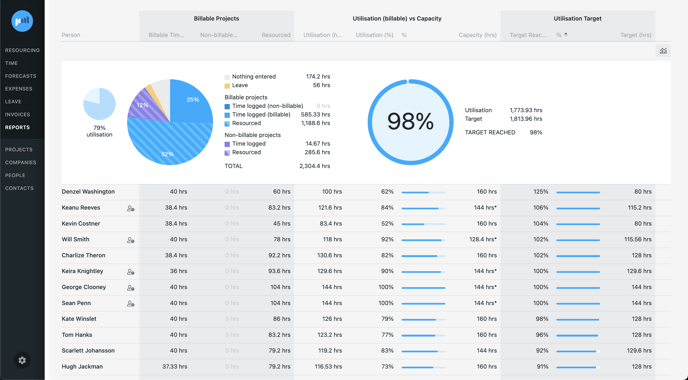
Understanding the calculations
In a nutshell, utilisation is the amount of a person’s capacity that is used for billable work and is expressed as a percentage. There are some nuances to this, and Projectworks gives you the flexibility to calculate utilisation and capacity to suit your business.
-
Capacity calculation: Whether leave is included or excluded when measuring against capacity
-
Utilisation calculation: Whether non-billable timecodes on billable projects are included or excluded in billable (utilised) time.
- Please note: the Utilisation calculation will always exclude time spent on non-billable projects.
The utilisation and capacity calculation settings can be configured by your Projectworks administrator within the the admin section, and should be considered “the way your business measures utilisation” - the reports will always default to these settings. You can toggle the calculations within a report if you want to see a different slant on the data, but they will always revert back to the business' preferred way of measuring.
Capacity calculation
For fixed / salaried staff, capacity is based on each person's work week structure on their posting, and always excludes public holidays.
For hourly staff, capacity is based on hours worked, not their work week. For example an hourly worker may have a standard 40 hour work week setup on their posting, but if they only record 20 hours in their timesheet or are only resourced for 20 hours in a future week, their capacity for that week is 20 hours. Again, public holidays are always excluded.
In addition to this, capacity can be calculated in one of two ways:
-
Measure against capacity minus leave: In short, a person's capacity will be reduced for any leave they have taken in the period. This lets you measure their utilisation based on the days they were available to work.
-
Measure against total capacity: Utilisation is measured against all days a person could work (if not on leave). This lets you measure their utilisation based on the days a person would be paid for.

Utilisation calculation
Historic utilisation
Timesheet entries are used to drive the backwards view of the utilisation target report (anything prior to the current date). There is an element of control over what work is included when calculating the historic utilisation. Within billable projects, either include or exclude work on non-billable timecodes.
Future utilisation
Resourcing data is used to drive the forward view of the utilisation target report (current date and onwards). The resourced value is calculated from the resourcing from date onwards, less any time entries for entered for that period.
Whether the project type is billable or non-billable determines whether resourcing will be reflected in the utilisation report.

Understanding the data
The table includes a lot of information and lets you learn a lot about the activity that has taken place. The Hide / Show / Group option can be used to customise the parts of the report you prefer to see. Select a period of time (this month, this year or a specific date range etc), and use the filters to focus on one part of the company if preferred.
Use the calculation settings to change the way capacity and utilisation is calculated.
General columns
-
Person
-
Role (hidden by default)
-
Agreement (hidden by default): Whether the person is a salaried or hourly worker.
- Utilisation Target (hidden by default): Percentage of a person’s capacity hours that should be spent on billable work.
-
Person working days (hidden by default)
-
All hours entered: (hidden by default) The total hours logged against projects or leave.
Leave
- Leave: (hidden by default) Any hours recorded through the leave process (any type of leave) are shown.
Non-billable Projects
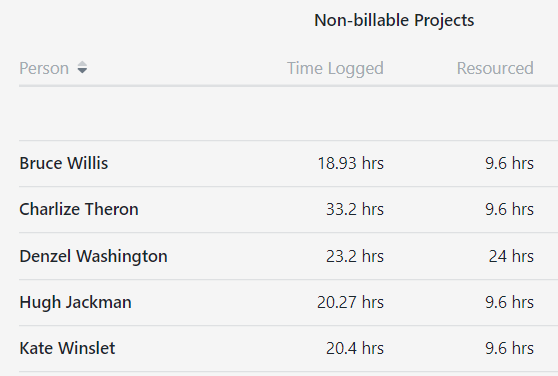
- Time logged (excludes hours after today) (hidden by default): Hours logged against non-billable projects up to and including the current date.
- Resourced (excludes hours before today) (hidden by default): Hours resourced against non-billable projects from the current date and onwards on projects.
Billable Projects
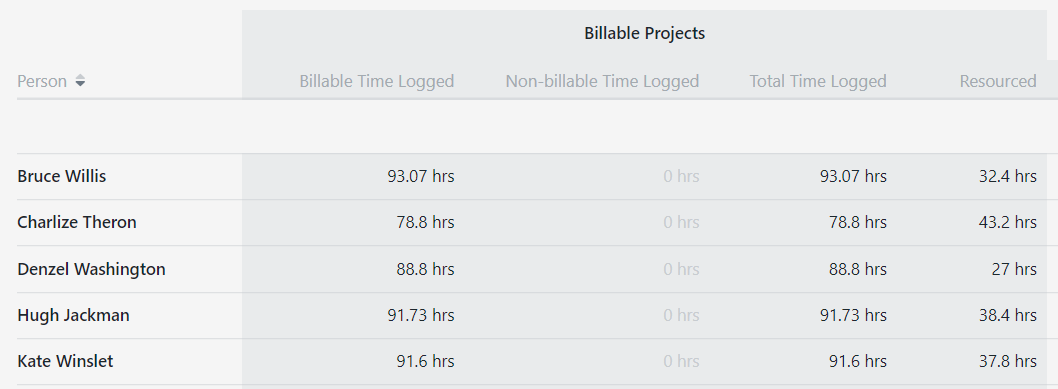
-
Billable time logged (excludes hours after today): Hours logged against billable timecodes up to and including the current date.
-
Non-billable time logged (excludes hours after today): Hours logged against non-billable timecodes on billable projects up to and including the current date.
- Total time logged (excludes hours after today): Total hours Hours logged against non-billable timecodes on billable projects up to and including the current date.
- Resourced (excludes hours before today): Hours resourced against billable projects from the current date and onwards.
Utilisation (billable) vs Capacity
Shows you billable hours against capacity. It is important to pay attention to calculation settings as they can influence what constitutes billable hours and whether this is measured against capacity with leave included or excluded.
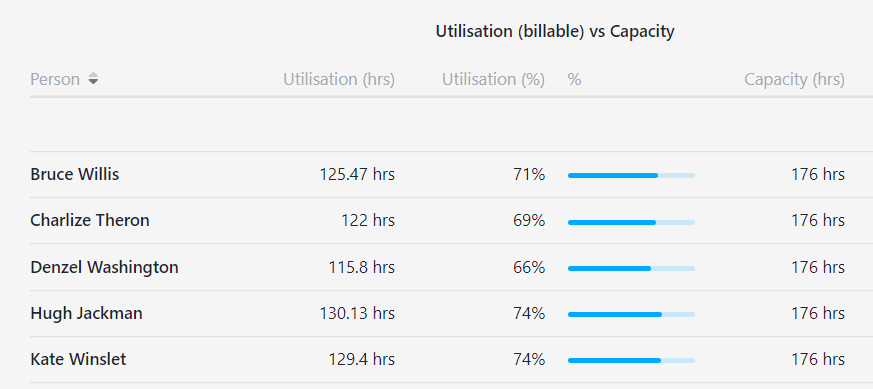
- Utilisation (hrs): The total hours on billable activities. Pay attention to the filters as time on non-billable timecodes on billable projects can be included or excluded from the calculation.
- Utilisation %: Calculated as Utilisation (hrs divided by Capacity (hrs).
- %: Visualistion of the progress to capacity
- Capacity (hrs): Total hours of capacity per person. Pay attention to the filters and whether capacity includes or excludes leave).
Measuring against capacity will let you see if there are additional hours available for people to work on billable projects.
Utilisation Target
Shows you billable hours against the billable target hours of each person. Utilisation targets are set on a person’s posting, and generally salaried people will have a utilisation target less than 100% of their capacity to reflect that some hours are required on internal or non-billable activities.
Contractors are likely to have a 100% utilisation target to reflect all their hours are expected to be logged on billable projects.
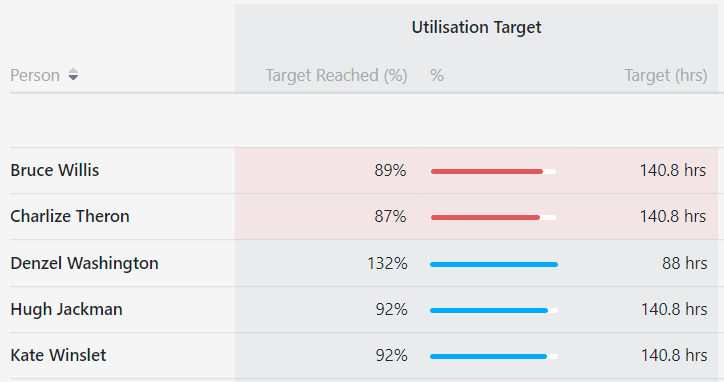
- Target reached (%): Calculated as Utilisation (hrs) divided by Target (hrs).
- %: Visualisation of the progress to target.
- Target (hrs): Set on a person’s posting
If utilisation targets have been set well across the company, being on track against target should mean your company is performing well financially.
Understanding the graphs
The graphs provide a great summary of performance against the utilisation target. If the report has been grouped a graph for each grouping of data is shown.

Time spent
The time spent graph takes into account all the time that has been (or could be) logged in the selected period of time.
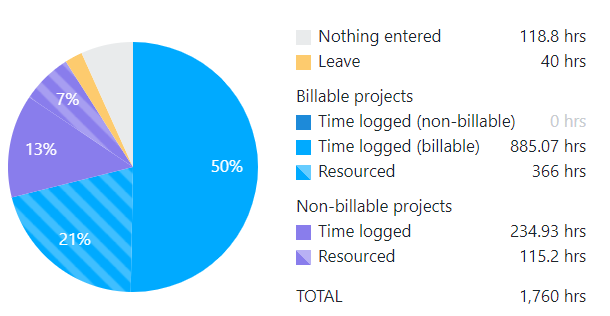
- Nothing entered: This is the gap between the total capacity and the time logged in timesheets or resourced.
- Leave: All hours of leave taken (all leave types)
- Billable Projects - Time logged (non-billable): Timesheet entries on billable timecodes up to the current date.
- Billable Projects - Time logged (billable): Timesheet entries on non-billable timecodes on billable projects up to the current date
- Billable Projects - Resourced: Hours resourced on billable projects from the current date.
- Non-billable Projects - Time logged: Timesheet entries on non-billable projects up to the current date
- Non-billable Projects - Resourced: Hours resourced on non-billable projects from the current date.
Utilisation Target
The utilisation graph provides the headline target reached percentage. It is calculated as the utilisation divided by the billable target hours. It is important to pay attention to calculation settings as they can influence what constitutes billable hours and whether the target is based on capacity including or excluding leave.

Your Projectworks administrator can set the threshold for when to highlight targets in red (bad/warning!). By default any target that is under 90% is highlighted red, but this can be changed to under 75%, under 50%, etc.
FAQs
How does non-billable work on billable projects factor into future utilisation?
Non-billable work on billable projects can only be factored into historic utilisation which uses time entries. Future utilisation uses resourcing which is done at a project level not a timecode level (which could be either billable or non-billable).
How are the default utilisation and capacity calculations set?
This is done in the admin section under Settings > “Include non-billable timecodes in the utilisation calculations by default“ and Settings > “Include leave in the utilisation calculations by default” respectively.
How can the threshold be changed for when the target graphs are highlighted red?
Your Projectworks administrator can change the percentage that is used to highlight when you're under target. This is done in the admin section under Settings > Utilisation Limit.
What is the difference between measuring against capacity or target?
Let’s make it simple and use a one week example, for Sam.
Sam is set up with a 40 hr week capacity, with a billable/util target of 75%
There are no holidays in the week so all 40 hours are available to be worked
Sam has worked 29.5 hours on billable timecodes/projects and 10.5 hours on non-billable projects
Measuring against capacity
Measures the amount of billable work against their full capacity hours.
For the example that would be … 29.5 / 40 = 73.75%
Measuring against target
Measures the amount of billable work against the billable/util target
For the example that would be 29.5 / (40 x 75% = 30) = 98.33%
The two results are very different. Neither is wrong, but is worth spending the time to understand which is the most important for you to focus on.
Should we be looking at Billable vs capacity, or billable vs target? Which number is more important to monitor?
There isn’t a right or wrong answer to this question.
Monitoring your utilisation rate against capacity will highlight any room to increase billable hours within the available capacity of the company. While not always 100% true, the more hours worked on billable projects the more revenue can be generated.
If utilisation targets have been set well across the company, being on track against target should mean your company is performing well financially.
Does “today” use time entries or resourcing?
For the current date, any time entries are used and then the remaining resourcing for the day.
